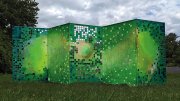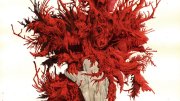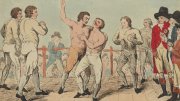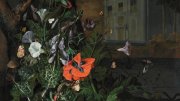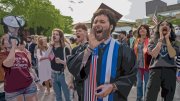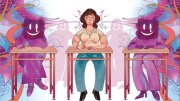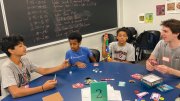On a Zoom call from her basement studio in early May, New York-based painter Julia Rooney ’11 shows me a part of a project she’s finishing—a series of camera-less photographic prints called cyanotypes.
Developed in the mid-1800s, the cyanotype process produces a blue image when specially-treated paper or fabric is exposed to light. Rooney shows me a small, stretched canvas with shapes cut out, which she props in front of a UV lamp. On the wall behind the canvas is a piece of photosensitized fabric. Rooney flips off an overhead light to let the fabric absorb the UV glow.
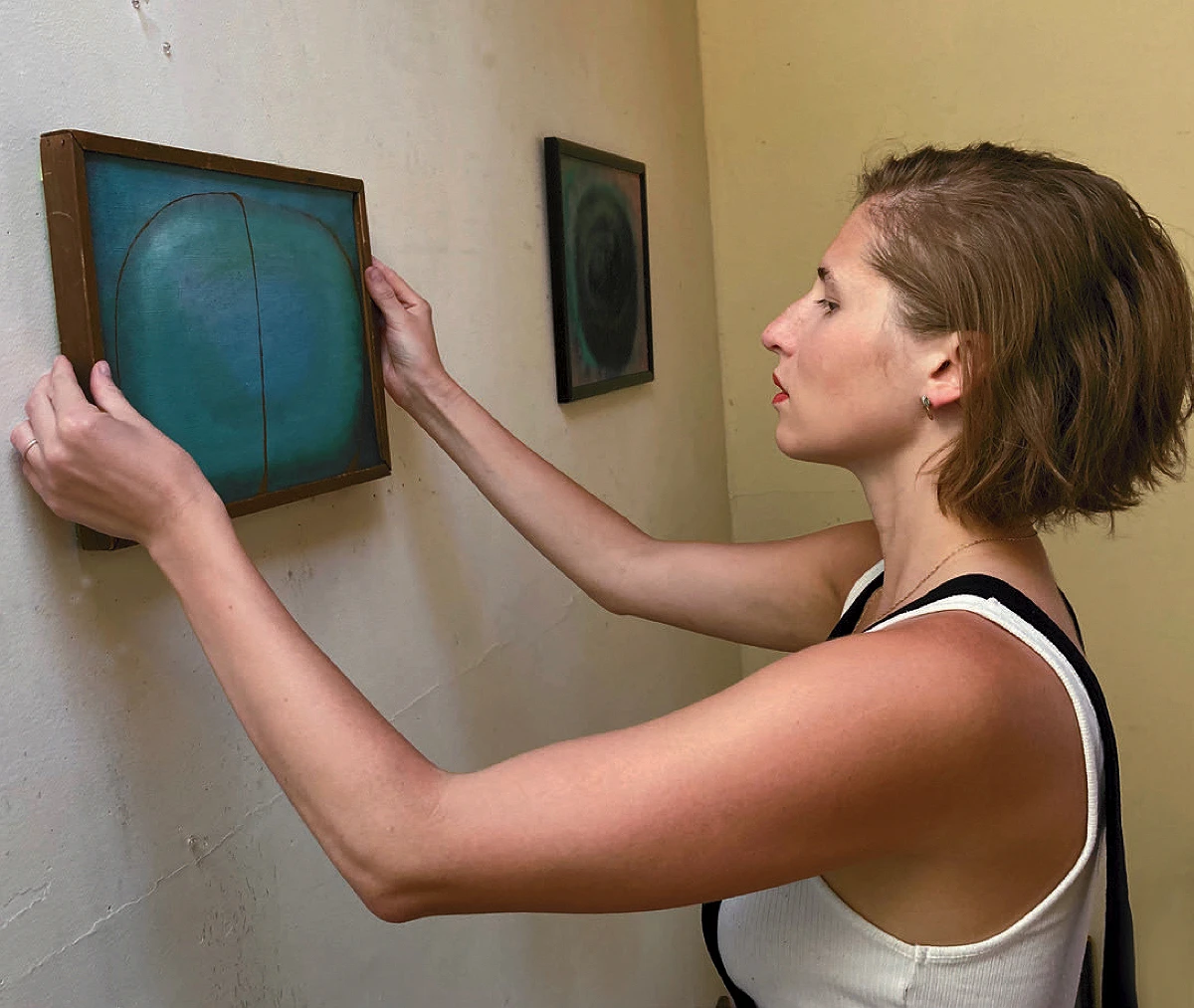
In the exhibit she’s preparing for the New Art Dealers Alliance (NADA) fair, Rooney’s finished cyanotype prints will complement a series of two-by-two-inch paintings, inspired by the scale of 35 mm slides. “I’m thinking about the relationship between digital and analog, between painting and photography, which is something I’ve been thinking about since I was in undergrad at Harvard,” Rooney says.
Rooney often creates art that evokes the aesthetic of digital technology, whether it’s freestanding, acrylic-painted “green screens” with tiny pixel squares cut out, oil paint on a wood panel resembling a colorful QR code, or paintings contained within a black smartphone border. While depicting twenty-first-century technology, much of Rooney’s work draws on old-world techniques, including the cyanotype—originally used for botanical illustration and blueprints—and hand stitching.
She enjoys the idea of feeding art back through itself: a painting of a smartphone’s depiction of a painting, a video of a three-dimensional piece of art, a still picture depicting the act of zooming in on a photo. Especially since the COVID pandemic, Rooney says, she’s thought a lot about the interplay between art and Instagram. A reluctant social media user herself, she is mindful of the online dopamine hits and joy-stealing comparisons that can bedevil young artists. As a teaching artist at the Museum of Modern Art, she passes on some wisdom from Stephen Prina, a professor of art, film, and visual studies who taught her intensive studio arts course at Harvard.
“Students are so hungry for validation and feedback,” Rooney says. “Some students, they just want to be told, ‘Is this right? Is this good? Is this not good?’ [Prina] would never do that. That is really hard, I think, as a young artist, to sit with. No one can tell you if what you’re doing is good or bad or if it’s worth pursuing or not. The only real person who should be answering that question is you.”
While preparing for the NADA show, Rooney is also planning a subsequent multimedia exhibit at Essex Flowers Gallery in New York City, co-produced with her sister Anne Marie Rooney, a Baltimore-based poet and frequent collaborator.
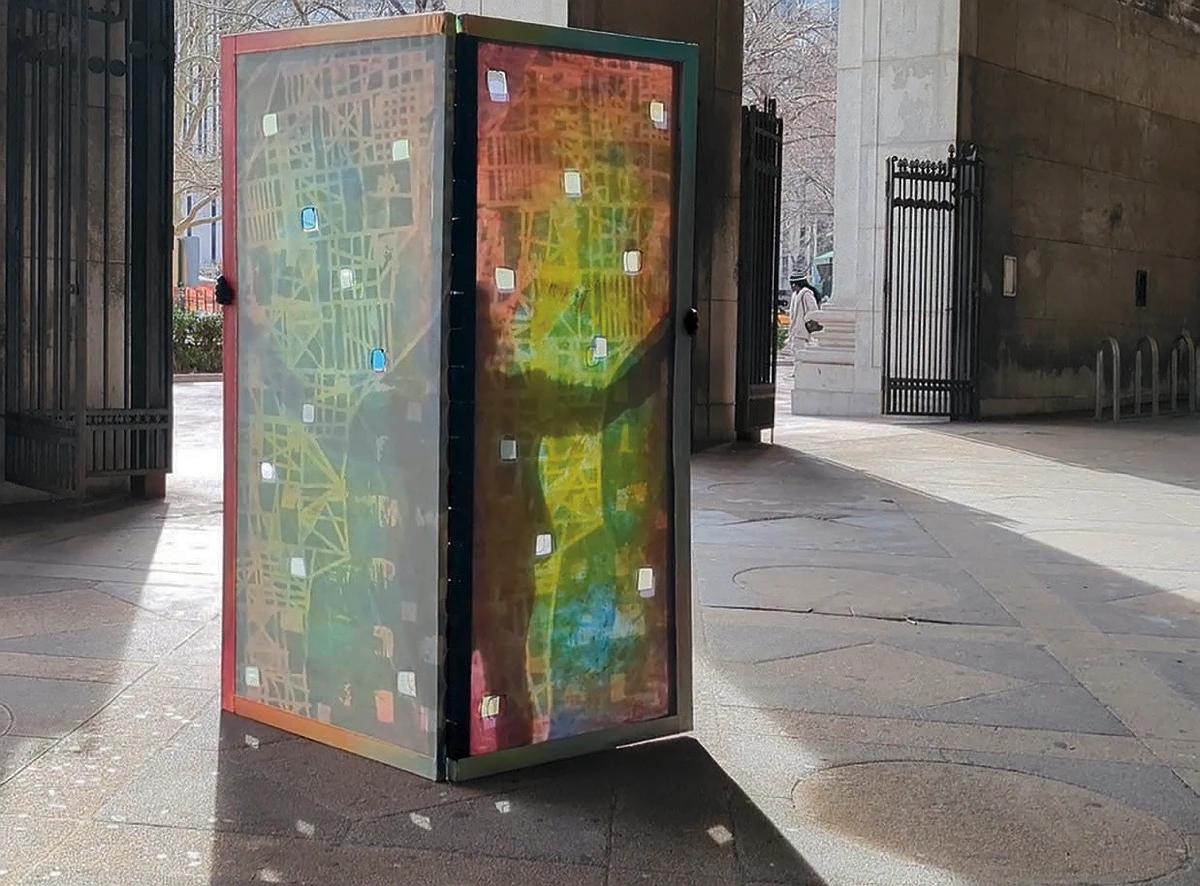
For their exhibit, called FLATS, Rooney has been constructing a series of black-and-white, QR-code-inspired postcard paintings into “a strange, unwieldy box.” The sisters will take the box to Washington, D.C., where they will film a performative walk from the National Mall to the Old Post Office Pavilion to highlight the role of the U.S. Postal Service as a federal agency. They see the postal service as a kind of collaborator. “So much of what happens in the mail involves it being touched by people and by machines and by systems that we are completely unaware of,” Rooney says. She will hold the assembled QR code structure, she says, while “Anne Marie will symbolically be ‘scanning’ through the act of filming me.” The sisters will screen the video in the gallery and display the QR code structure.
This is not the first time the Rooney sisters have made performance art together. Last year, they produced an exhibition for which Anne Marie shot video of Julia schlepping a cumbersome six-by-six-foot painting—a bright blue mixed media canvas—three and a half miles through the streets of Lower Manhattan. They mapped the journey to pass by places the Rooney sisters had looked up in the New York Historical Society’s archive of subway construction photographs from the early twentieth century. In the video, the vintage images are occasionally projected onto the blue screen. With this project, as they observed how a painting withstands being dragged through space and time, the sisters were “trying not to laugh [at] the absurdity,” Anne Marie explains, “and just kind of playing together.”
The two women have an easy creative relationship, based on a sisterly shorthand. “We are very direct with each other. We’re very silly,” the poet says. “We like to make each other laugh.” The Rooney sisters grew up in Tribeca with an art therapist mother and a father who worked as a professional indexer. Growing up, Anne Marie says, “There wasn’t a lot of scarcity around art in our house. It was just like, the more art the better.” It was the perfect setup for a lifelong artistic relationship. “We’re collaborating not because we’re sisters, but because she’s a writer who I respect and I’m an artist who she respects,” Julia says. “I feel like there’s a way in which I can access a different part of myself because of her writing.”
After an hour of talking about her art, life, and family, Rooney offers to demonstrate how the cyanotype image is developed. She turns off the UV light and removes the treated cloth. “The area that was exposed to light becomes dark blue. The area that was blocked from the light stays white,” she explains, running the photosensitized fabric under the faucet in a drop sink to reveal the pattern of rectangles, trapezoids, and triangles from the canvas, a bit like a chaotic blue-and-white Amish blanket.
Rooney will eventually cut the fabric up and use it as a canvas for her tiny paintings inspired by photo slides. “This is just an example of how the process works,” she says. “I’m thinking about this question of, how can a painting create a photograph of itself as opposed to always being the subject of photography?”
